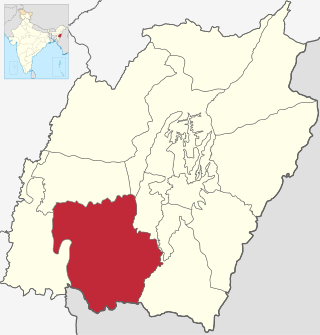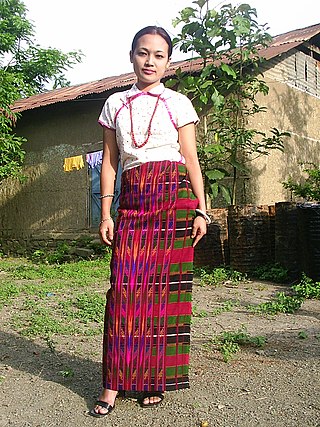The Hmar language belongs to the Mizo language branch of the Sino-Tibetan family of languages. The speakers of this language use Mizo language as their second language (L2).

The Mizo people, historically recorded as the Lushais, are an ethnic group native to the state of Mizoram in India and neighbouring states of Northeast India. They speak the Tibeto-Burman language of Mizo, the official language and lingua franca of Mizoram. The state is the second most literate state in India, at more than a rate of 90%.

The Chin people are an ethnic group native to the Chin State and Rakhine State of Myanmar. Strictly speaking, the term "Chin" only refers to the 53 sub-tribes of the Chin ethnic group, divided and recognized by the Burmese government. They speak the Kuki-Chin-Mizo languages, which are often mutually unintelligible but are closely related.

Churachandpur District, is one of the 16 districts of the Indian state of Manipur populated mainly by Kuki-Zo people. The name honours former Maharaja Sir Churachand Singh of Manipur. The district headquarters is located in the Churachandpur town, which is also locally known by the name Lamka.
The Paite people are an ethnic group in Northeast India, mainly living in Manipur and Mizoram. The Paites are recognized as a scheduled tribe in these two states. They are part of the Kuki-Zo people, but prefer to use the Zomi identity. "Guite" is a major clan of the Paite people.

The Kuki people are an ethnic group in the Northeastern Indian states of Manipur, Nagaland, Assam, Meghalaya, Tripura and Mizoram, as well as the neighbouring countries of Bangladesh and Myanmar. The Kukis form one of the largest hill tribe communities in Northeast India, along with the adjoining regions of Bangladesh and Myanmar. In Northeast India, they are present in all states except Arunachal Pradesh. The Chin people of Myanmar and the Mizo people of Mizoram are kindred tribes of the Kukis. Collectively, they are termed the Zo people.

The Mizo language is a Tibeto-Burman language spoken mainly in the Indian state of Mizoram, where it is the official language and lingua franca. It is the mother tongue of the Mizo people and some members of the Mizo diaspora. Other than Mizoram, it is also spoken in Meghalaya, Manipur, Tripura, and Assam states of India, Sagaing Region and Chin State in Myanmar, and Chittagong Hill Tracts of Bangladesh. It is mainly based on the Lusei dialect but it has also derived many words from its surrounding Mizo clans.

The Zou people Is are an ethnic group, that is an indigenous community living along the frontier of India and Burma, they are a sub-group of the Kuki people/Zo people. In India, they live with and are similar in language and habits to the Thadou people and Paite and the Simte peoples. In Burma, the Zou are counted among the Chin people. They are a hill people, "Zou" may plainly means "Hills" denoting the Zous are "people of the hills" or "of the hills", and "Zou" has also a different meaning in Zou language that is "complete" or another word for it is "finish". But, the Zou people believed that they incepted the name 'Zou' from their forefather 'Zou' or 'Zo', believed to be the progenitor of the broad Chin-Kuki-Mizo people.
Guite is the progenitor clan of Zomi people, also called Chin in Myanmar, Mizo, or Paite, or even Kuki in India. According to Zam, Nigui Guite is the elder brother of the ancestral fathers of the Thadou people, namely Thangpi, Sattawng, and Neirawng. This genealogy was recently inscribed on the tribal memorial stone at Bungmual, Lamka in the presence of each family-head of the three major clans, Doungel, Kipgen, and Haokip, on August 7, 2011. Some historians, like Shakespeare, assumed Lamlei was the Nigui Guite himself but the Guites themselves recounted Tuahciang, the father of Lamlei, as the son of Nigui Guite instead, in their social-religious rites. Regarding Guite as the born son of Songthu and his sister, Nemnep, it was the practice of ancient royalty to issue royal heir and also to keep their bloodline pure instead. Depending on local pronunciation, the clan was also called by different names such as Nguite or Vuite, Gwite, Nwite, Paihte by the Lushei. In accord with the claim of their solar origin, the Guite clan has been called nampi, meaning noble or major or even dominant people, of the region in local dialect in the past.
The Lai people mainly inhabit the southern parts of Chin Hills in Myanmar's Chin State, in the townships of Falam, Thantlang and Hakha. They are also found in the Lawngtlai district of Mizoram, India, where they have been granted the Lai Autonomous District Council. Outside this area they are scattered in Mizoram and in Manipur. Their languages "Laizo Lai" and "Hakha Lai" are classified as Central Kuki-Chin languages.

Zogam known as Zoland, Zoram, Lushai Hills, Kuki Hills, lies in the northwest corner of the Mainland Southeast Asia landmass. This is the traditional ancestry homeland of the Zo people or Zomi who lived in this area before the colonial period under British rulership.
The Tedim people, also called Tedim Chins and Tiddim (Hai-Dim) people, are a Zo tribe, part of the Chin people, primarily inhabiting the Tedim Township in the Chin State of Myanmar. They speak the Tedim language, a northern Kuki-Chin language.
The Kuki-Chin languages are a branch of the Sino-Tibetan language family spoken in northeastern India, western Myanmar and southeastern Bangladesh. Most notable Kuki-Chin-speaking ethnic groups are referred to collectively as the Zo people which includes: the Mizo of Mizoram, the Kuki of Manipur, and the Chin of Chin State, Myanmar.
The Kuki–Paite Conflict, also called Kuki–Zomi Conflict, was an ethnic conflict during 1997–1998 between tribal communities in Churachandpur district in Manipur, India. The cause of the conflict may be regarded as the desire for leadership within the tribes, pitting one group that subscribed to the Kuki label against another group that subscribed to the Zomi label, the latter being led by the Paites. The conflict started in June 1997 and lasted for over year, during which 352 people died, thousands of homes were destroyed and over 13,000 people were displaced. The Government of India sent in the Indian Army to attempt to stop the violence, but peace was restored in September–October 1998 only with the initiative of the Church.

The Zomi Revolutionary Army (ZRA) is an armed Zomi nationalist insurgent group formed in 1997, following an increase in ethnic tensions between the Kuki people and the Paites tribe in Churachandpur district of Manipur, India. Its parent organisation, the Zomi Revolutionary Organisation, was founded in April 1993.
The Zo people is a term to denote all the speakers of the Kuki-Chin languages who inhabit northeast India, western Myanmar, and southeastern Bangladesh. The Mizo, Chin, and Kuki–Zomi people are the main ethnic groups.
Vaiphei is a Sino-Tibetan language belonging to the Kuki-Chin linguistic subbranch of the Tibeto-Burman group of languages. It is spoken mainly in the Myanmar minutely in Manipur-KukiZogam, Mizoram, Assam, Meghalaya, and Tripura. The dialect spoken in Myanmar exhibits a least partial mutual intelligibility with the other Mizo/Kukish dialects of the area including Thadou, Hmar, Paite, Simte, Kom and Gangte languages.

The Neihsial is an ethnic group found in northeastern India and parts of Myanmar. Members of this group are largely concentrated in the Churachandpur, Senapati, Chandel District and Tamenglong district of the Indian state of Manipur. There is also a sizable population in the neighboring Chin State of Myanmar.

The Zomi Congress for Democracy, formerly Zomi National Congress, is a political party in Myanmar. Originally formed in Manipur, India, most of its current support comes from Chin State, where the party was originally headquartered. The party is most popular in the Tonzang and Tedim Townships, where their headquarters and strongholds are. The party has 15,000 members in Chin State.
Northern Kuki-Chin is a branch of Kuki-Chin languages. It is called Northeastern Kuki-Chin by Peterson (2017) to distinguish it from the Northwestern Kuki-Chin languages. VanBik (2009:31) also calls the branch Northern Chin or Zo.










